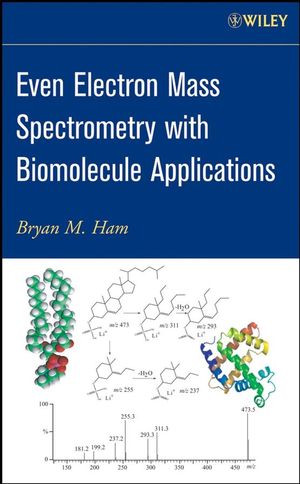Even Electron Mass Spectrometry with Biomolecule ApplicationsISBN: 978-0-470-11802-3
Hardcover
440 pages
April 2008
 This is a Print-on-Demand title. It will be printed specifically to fill your order. Please allow an additional 10-15 days delivery time. The book is not returnable.
|
||||||
Acknowledgements.
Dedication.
Glossary, Abbreviations, and Definitions.
Chapter I: Introduction and Fundamentals.
1.1 Definition and Description of Mass Spectrometry.
1.2 Basic Design of Mass Analyzer Instrumentation.
1.3 Mass Spectrometry of Protein, Metabolite, and Lipid Biomolecules.
1.3.1 Proteomics.
1.3.2 Metabolomics.
1.3.3 Lipidomics.
1.4 Fundamental Studies of Biological Compound Interactions.
1.5 Mass-to-Charge Ratio (m/z) - How the Mass Spectrometer Separates Ions.
1.6 Exact Mass versus Nominal Mass.
1.7 Mass Accuracy and Resolution.
1.8 High Resolution Mass Measurements.
1.9 Rings Plus Double Bonds (r + db).
1.10 The Nitrogen Rule in Mass Spectrometry.
1.11 Chapter Problems.
1.12 References.
Chapter II: Ionization in Mass Spectrometry.
2.1 Ionization Techniques and Sources.
2.2 Electron Ionization (EI).
2.3 Chemical Ionization (CI).
2.3.1 Positive Chemical Ionization.
2.3.2 Negative Chemical Ionization.
2.4 Atmospheric Pressure Chemical Ionization (APCI).
2.5 Electrospray Ionization (ESI).
2.6 Nano-Electrospray Ionization (nano-ESI).
2.7 Atmospheric Pressure Photo Ionization (APPI).
2.7.1 APPI Mechanism.
2.7.2 APPI VUV Lamps.
2.7.3 APPI Sources.
2.7.4 Comparison of ESI and APPI.
2.8 Matrix Assisted Laser Desorption Ionization (MALDI).
2.9 Fast Atom Bombardment (FAB).
2.9.1 Application of FAB versus EI.
2.10 Chapter Problems.
2.11 References.
Chapter III: Mass Analyzers in Mass Spectrometry.
3.1 Mass Analyzers.
3.2 Magnetic and Electric Sector Mass Analyzer.
3.3 Time-of-Flight Mass Analyzer (TOF/MS).
3.4 Time-of-Flight/Time-of-Flight Mass Analyzer (TOF-TOF/MS).
3.5 Quadrupole Mass Filter.
3.6 Triple Quadrupole Mass Analyzer (QQQ/MS).
3.7 Three Dimensional Quadrupole Ion Trap Mass Analyzer (QIT/MS).
3.8 Linear Quadrupole Ion Trap Mass Analyzer (LTQ/MS).
3.9 Quadrupole/Time-of-Flight Mass Analyzer (Q-TOF/MS).
3.10 Fourier Transform Ion Cyclotron Resonance Mass Analyzer (FTICR/MS).
3.10.1 Introduction.
3.10.2 FTICR Mass Analyzer.
3.10.3 FTICR Trapped Ion Behavior.
3.10.4 Cyclotron and Magnetron Ion Motion.
3.10.5 Basic Experimental Sequence.
3.11 Linear Ion Trap Fourier Transform Mass Analyzer (LTQ-FT/MS).
3.12 Linear Ion Trap Orbitrap Mass Analyzer (LTQ-Orbitrap/MS).
3.13 Chapter Problems.
3.14 References.
Chapter IV: Collision and Unimolecular Reaction Rate Theory.
4.1 Introduction to Collision Theory.
4.2 Non-covalent Bond Dissociation Energy.
4.3 Low Molecular Weight BDE Predictive Model.
4.4 Computer Modeling of BDE Values.
4.5 High Molecular Weight BDE Predictive Model.
4.6 Non-covalent BDE of Li+ Adduct of Mono-pentadecanoin.
4.7 Practice Problems.
4.7.1 Problem 1.
4.7.2 Problem 2.
4.7.3 Problem 3.
4.7.4 Problem 4.
4.7.5 Problem 5.
4.8 BDE Determination of Li+ Lipid Dimer Adducts.
4.9 Covalent Apparent Threshold Energies of Li+ Adducted Acylglycerols.
4.9.1 Apparent Threshold Energy Predictive Model.
4.9.2 Apparent Threshold Energies for Lithiated Mono-pentadecanoin.
4.9.3 Apparent Threshold Energies for Lithiated 1-Stearin,2-palmitin.
4.9.4 Apparent Threshold Energies for Lithiated 1,3-Dipentadecanoin.
4.10 Computational Reaction Enthalpies and Predicted Apparent Threshold Energies.
4.11 Conclusions.
4.12 References.
Chapter V: The Mass Spectrum: Odd Electron Molecular Ion versus Even Electron Precursor Ion Mass Spectra.
5.1 Electron Ionization (EI) Odd Electron (OE) Processes.
5.2 Oleamide Fragmentation Pathways ? Odd Electron M+ú by Gas Chromatography/Electron Ionization-Mass Spectrometry (GC/EI-MS).
5.3 Oleamide Fragmentation Pathways ? Even Electron [M+H]+ by Electrospray Ionization/Ion Trap Mass Spectrometry (ESI/IT-MS).
5.4 Problem: Methyl Oleate EI Mass Spectrum.
5.5 References.
Chapter VI: Product Ion Spectral Interpretation.
6.1 Introduction to Product Ion Spectral Interpretation.
6.2 Structural Elucidation of 1,3-dipentadecanoin.
6.3 Problem: Lithiated Mono-penradecanoin Product Ion Spectrum.
Chapter VII: Proteomics.
7.1 Introduction to Proteomics.
7.2 Protein Structure and Chemistry.
7.3 Bottom-up Proteomics ? Mass Spectrometry of Peptides.
7.3.1 History and Strategy.
7.3.2 Protein Identification Through Product Ion Spectra.
7.3.3 High Energy Product Ions.
7.3.4 De Novo Sequencing.
7.3.5 Electron Capture Dissociation (ECD).
7.4 Top-down Proteomics: Mass Spectrometry of Intact Proteins.
7.4.1 Background.
7.4.2 Gas-Phase Basicity and Protein Charging.
7.4.3 Calculation of Charge State and Molecular Weight.
7.4.4 Top-Down Protein Sequencing.
7.5 Post Translational Modification of Proteins (PTM).
7.5.1 Three Main Types of PTM.
7.5.2 Glycosylation of Proteins.
7.5.3 Phosphorylation of Proteins.
7.5.3.1 Phosphohistidine as Post Translational Modification.
7.5.4 Sulfation of Proteins.
7.5.4.1 Glycosaminoglycan Sulfation.
7.5.4.2 Tyrosine Sulfation.
7.6 Systems Biology and Bioinformatics.
7.6.1 Biomarkers in Cancer.
7.7 Chapter Problems.
7.8 References.
Chapter VIII: Biomolecule Spectral Interpretation - Small Molecules.
8.1 Introduction.
8.2 Ionization Efficiency of Lipids.
8.3 Fatty Acids.
8.3.1 Negative Ion Mode Electrospray Behavior of Fatty Acids.
8.4 Quantitative Analysis by GC/EI Mass Spectrometry.
8.5 Wax Esters.
8.5.1 Oxidized Wax Esters.
8.5.2 Oxidation of Monounsaturated Wax Esters by Fenton Reaction.
8.6 Sterols.
8.6.1 Synthesis of Cholesteryl Phosphate.
8.6.2 Single Stage and High Resolution Mass Spectrometry.
8.6.3 Proton Nuclear Magnetic Resonance (1H-NMR).
8.6.4 Theoretical NMR Spectroscopy.
8.6.5 Structural Elucidation.
8.7 Acylglycerols.
8.7.1 Analysis of Monopentadecanoin.
8.7.2 Analysis of 1,3-Dipentadecanoin.
8.7.3 Analysis of Triheptadecanoin.
8.8 ESI-Mass Spectrometry of Phosphorylated Lipids.
8.8.1 Electrospray Ionization Behavior of Phosphorylated Lipids.
8.8.2 Positive Ion Mode ESI of Phosphorylated Lipids.
8.8.3 Negative Ion Mode ESI of Phosphorylated Lipids.
8.9 Chapter Problems.
8.10 References.
Chapter IX: Biomolecule Spectral Interpretation - Biological Macromolecules.
9.1 Introduction.
9.2 Carbohydrates.
9.2.1 Ionization of Oligosaccharides.
9.2.2 Carbohydrate Fragmentation.
9.2.3 Complex Oligosaccharide Structural Elucidation.
9.3 Nucleic Acids.
9.3.1 Negative Ion Mode of a Yeast 76-mer tRNAPhe.
9.3.2 Positive Ion Mode MALDI Analysis.
9.4 Chapter Problems.
9.5 References.
Chapter X: MALDI-TOF-Postsource Decay (PSD).
10.1 Introduction.
10.2 Metastable Decay.
10.3 Ion Mirror Ratio Measurement of PSD Spectra.
10.4 PSD of Phosphatidylserine.
10.4.1 Problem 10.1.
10.5 PSD of Phosphatidylcholines.
10.5.1 Problem 10.2.
10.5.2 Problem 10.3.
10.6 PSD of Phosphatidylglycerol.
10.6.1 Problem 10.4.
10.6.2 Problem 10.5.
Appendix I: Atomic Weights and Isotopic Compositions.
Appendix II: Chapter Problem Solutions.
Appendix III: Table of Physical Constants.
Index.



